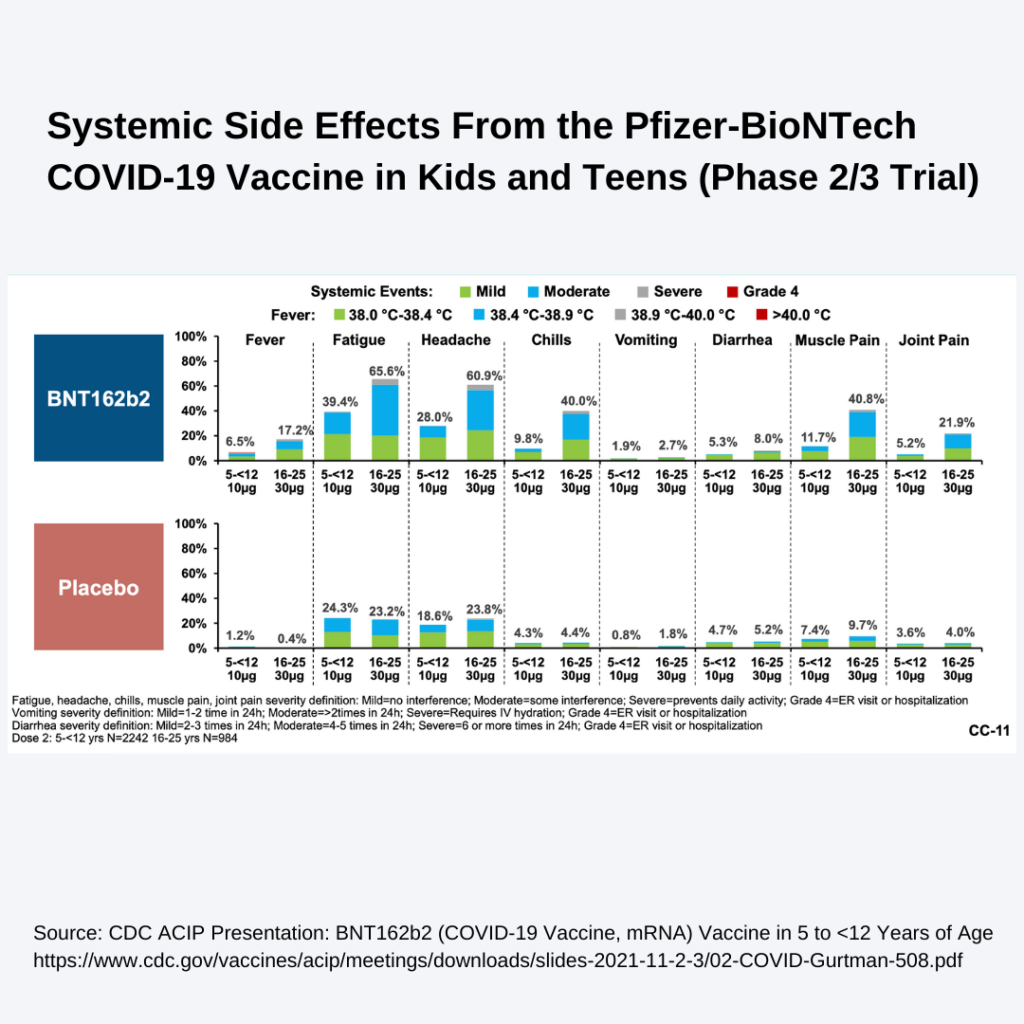A: The side effects from COVID-19 vaccines are similar to those from flu shots.
The most common reactions are pain at the injection site, fatigue, and headache. Symptoms are typically mild to moderate and resolve in 1-2 days. Kids who had already been infected with COVID-19 tend to have fewer side effects.
To understand what to expect in more detail, let’s look at the Pfizer Phase 2/3 clinical trial data. In this study, over 3000 kids got the real deal, and about 1500 got a fake shot (placebo). Side effects were closely monitored, both locally (at injection site) and elsewhere in the body (systemic). Here is what we saw, from most to least common.
SIDE EFFECTS: WHAT TO EXPECT
Local reactions: Pain at the injection site (74%), redness (19%), swelling (15%).*
Systemic reactions: Fatigue (39%), headache (28%), muscle pain (12%), chills (10%), fever (7%), diarrhea (5%), joint pain (5%), vomiting (2%).*
It’s worth noting that many kids who got the fake shot (placebo) also experienced side effects like fatigue (24%), headache (20%), and muscle pain (7%). In some cases, they were just as common after the real and fake shots (e.g. 5% for diarrhea). Our expectations often color our experiences.

*Side effects rates varied slightly between doses. The dose with higher rate is listed. See figures for details.
IMPACT OF PREVIOUS COVID-19 INFECTIONS
Kids who had already been infected with COVID-19 had fewer side effects, especially after their second dose. They were less likely to experience either local symptoms like swelling (7% vs 16%) and redness (10% vs 19%) or systemic reactions like fever (3% vs 7%) and fatigue (28% vs 40%).
WAS THERE ANYTHING MORE SERIOUS?
The most serious vaccine reaction was a very high fever, in one of the 3,000 children who got the real shot. This child recovered with no medical consequences.
There were a few very serious medical events during the trial – in both the vaccine and the placebo group. As in all clinical trials, these events are reviewed by independent examiners to determine whether or not they were related to the vaccine. They were all deemed unrelated to the shot. Here they are – they speak for themselves:
Vaccine Group (~3000 kids, 4 events): limb fracture, knee infection, epiphysial fracture, and my favorite – a kid who ate a penny!
Placebo Group: (~1500 kids, 2 events): pancreatitis, abdominal pain
This is an important reminder that bad things happen, and we can’t always assume that they were caused by whatever you just did (e.g. “Oh no! I just got a parking ticket. It must be because a black cat crossed my path.” Probably not.).
Note: The trial was not big enough to detect super rare events, those that occur in less than 1 in 1,000 kids. Experts anticipate that a tiny fraction of kids will develop myocarditis based on what we have seen in teens. Most experts think it will be extremely rare (one in many thousands), based on what we know about this disease and the smaller dose. However, we can’t yet put a number on this risk. More on this in a future post!
THE BOTTOM LINE
Side effects are no fun, but they are not reason for alarm. The temporary and typically mild symptoms are outweighed by the upside of protecting your child and others. Ideally, time your kids’ shot so they can lay low for a day or two. You can use pain relievers for kids if desired, after vaccination (but not before).
As always, don’t hesitate to contact your local healthcare provider if your child experiences any medical concerns.
Resources:
CDC presentation on COVID-19 vaccine risks vs benefits in kids age 5-11
DP Links:
Dear Pandemic video: FAQ for vaccines in kids 5-11
FDA is underestimating the benefits of vaccinating kids against COVID-19
How do I help prepare my child for the COVID-19 vaccine?


